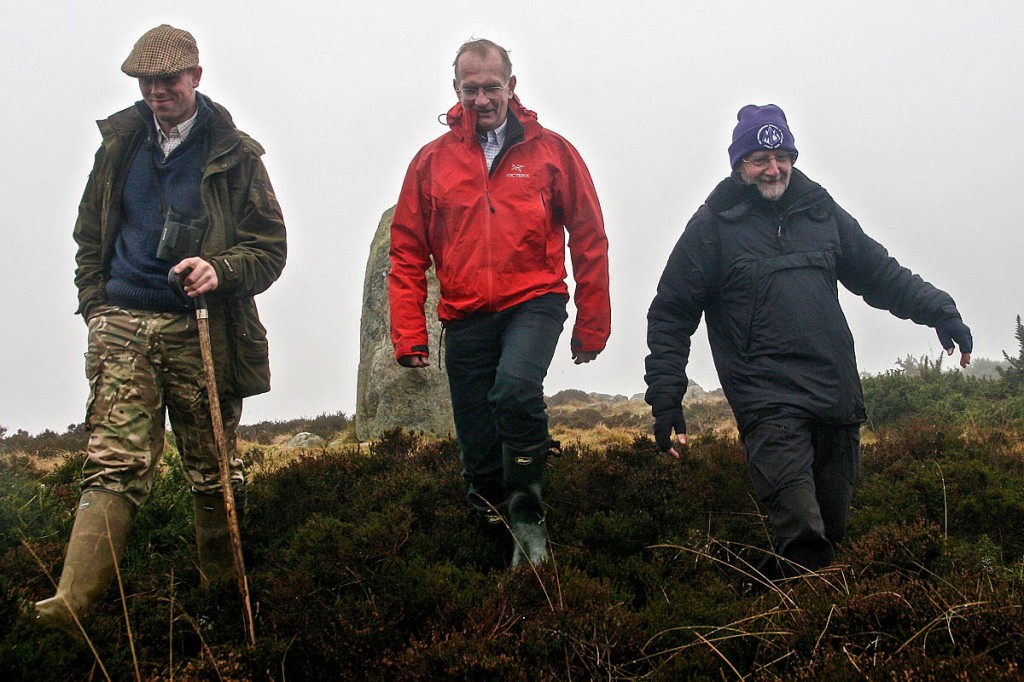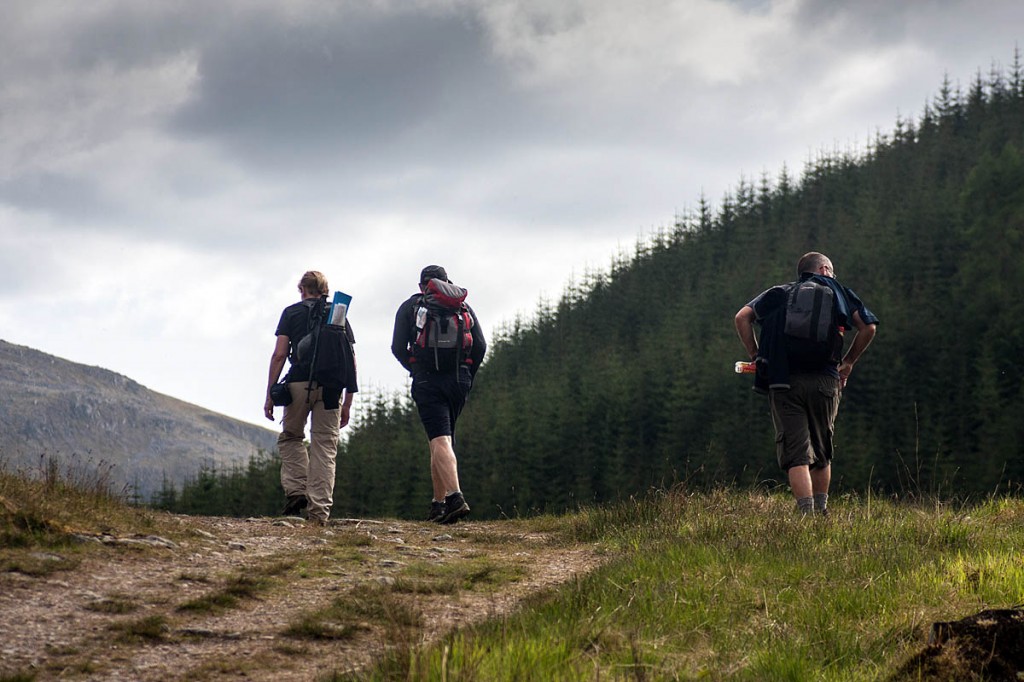
Perthshire gamekeeper Josh Burton, left, is joined by Mountaineering Scotland president Mike Watson and Mountaineering Scotland volunteer Dave Gordon, right.
An unlikely alliance of two traditionally opposing bodies is urging the Scottish Government to protect the open landscapes for which the nation is renowned.
Mountaineers and gamekeepers, often at loggerheads over outdoors policy, have agreed to press the Holyrood administration to introduce a policy to protect Scotland’s uplands.
The Scottish Gamekeepers Association and Mountaineering Scotland, which represents hillwalkers, climbers and mountaineers north of the border, said large-scale afforestation could ruin celebrated vistas.
The two organisations have written jointly to environment minister Roseanna Cunningham to voice concerns over fragmented policy on open landscapes. The two bodies admit they do not agree on all matters but said they have memberships who share a passionate interest in the nation’s landscapes.
They said: “While Scotland’s open landscapes and upland moors are classed as rare in global terms, there is currently no policy position safeguarding them. Some areas are designated as of special ecological or scenic interest but most are unprotected and disregarded.”
They said neither body opposes well sited, planned tree planting, but both question whether enough weight is being given to the significant changes this will have on the landscape and access.
In particular, they are worried that the dramatic open views and vistas, regarded as iconic of Scotland, may disappear.
They pointed out successive Scottish administrations have published detailed forestry strategies and targets, with 10,000ha (24,700 acres) of new planting earmarked to take place each year until 2022.
Mike Watson, president of Mountaineering Scotland, said: “The SGA and ourselves have different views on a number of issues, but we have a common interest in the development of a land-use policy that will protect the landscapes that we both value.
“Mountaineering Scotland will continue working to ensure access to mountain areas for our members, and it is imperative that the landscape of these areas is protected from inappropriate development.
“We hope that a joint approach to the Scottish Government from our two organisations will demonstrate the wide-ranging concern over this issue, and the need for development of a coherent policy that takes into account the views of all interested parties.”
Both bodies welcome Scottish Natural Heritage’s preparatory work on outlining a strategic vision for the uplands, arguing that, without such a vision, key areas may be given up to agriculture, energy and afforestation, with insufficient attention paid to what is being lost.
They are seeking a meeting with the environment minister to discuss what they see as a ‘failure to join up what is required from the land to meet forestry targets and what we might want to keep in terms of internationally rare and valuable landscapes and ecosystems’.
The two organisations would like Scottish Government to share its own thinking on the relative values of woodland and moorland and have offered joint support in developing a strategic vision and plan for Scotland’s uplands.
Alex Hogg, chairman of the Scottish Gamekeepers Association, said: “Recent dialogue between both organisations established a great deal of common ground when it came to the pride our respective memberships have in the land, but also their worries about upland landscapes and how different they may look, in the not too distant future, if we don’t have a landscape policy which gives them the emphasis required.
“We have lost so much open moorland since the 1940s and a narrow view, now, may fail what we have left.”

matthew dalby
15 February 2017UNBELIEVABLE!
Given the amount of environmental and ecological destruction carried out by gamekeepers, burning vast areas of heather, draining bogs, killing protected birds of prey etc. to claim to be standing up for Scotland's natural heritage is nothing short of blatant hypocrisy. Shame on Mountaineering Scotland for having anything to do with a bunch of criminals and ecological vandals.
Scotland's open moors and uplands are rare in international terms because they are a totally unnatural habitat and most other countries are fortunate not to have suffered such a level of environmental destruction. The natural state for most of the Highlands is to be forested, or at higher elevations, covered in scrub. How incredibly narrow minded of Mountaineering Scotland to be against ecological restoration especially when there is so much destruction still taking place elsewhere. I would have thought that mountaineers would care about the mountain environment and be happy that it was being restored to a more natural state.
Yes commercial plantations, if poorly planned, can be a blight on the landscape, but no more so than intensively managed grouse moors with their regular strips of burnt heather. Even plantations of non native conifers probably support more wildlife than intensively managed moorland, and the forestry commission certainly don't kill legally protected raptors, unlike some Scottish gamekeepers.
It is surely better that timber is produced in a relatively sustainable way in Scotland rather than importing timber from old growth forests elsewhere in the world, even if it means tarnishing a few views.
It's about time people started looking beyond their narrow self interests and considered the wider environment.
I'm very disappointed by Mountaineering Scotland, as someone who does a lot of mountaineering in Scotland they certainly don't represent me or my views. I have canceled my membership and would urge anyone else who cares about the mountains to do the same.
GMC
16 February 2017Absolutely right, Matthew Dalby.
The British Isles is the most terribly deforested area in an anyway heavily, heavily deforested Europe.
Our lack of really natural habitats is utterly scandalous, all throughout the UK.
(While Scotland of course isn't nearly as bad, perhaps not even comparable to the terribleness of near vegetation free Northern Ireland. Though the right to roam in Scotland which is absent in the rest of the UK ought to mean that more effort is put into reforestation.)
You cannot talk about these areas in terms of natural habitats, there is nothing natural about them.
Their main inhabitants are carefree walkers of a certain mindset - who like to dominate all they survey for their weekend excursion. Where the removal of what would naturally grow there is subconsciously some kind of imperialism to control freaks of a type.
Timbo
16 February 2017I agree with Matthew
Mike
16 February 2017Well said, Matthew (and GMC).
How bizarre that a mountaineering body should side with one that clearly favours the complete eradication of any form of fauna other than grouse on vast swathes of the Scottish highlands and upland areas.
Time to ban driven grouse shooting! It has no place in a modern, civilised and compassionate world.
Neil Reid (Mountaineering Scotland communications officer)
16 February 2017You may agree or disagree on the decision by Mountaineering Scotland to issue a joint letter with the SGA, but should be aware that the level of agreement referred to is agreement that the Scottish Government should devise a landscape policy for Scotland. That is: agreement that there should be such a policy - not what the content of that policy may be. In the wake of misunderstanding, and of people reading into this that which wasn't there, this clarification was issued yesterday: https://www.mountaineering.scot/news/clarification-on-joint-press-release-with-sga
Colin Wells
16 February 2017Before folk jump to conclusions it should be pointed out that the Scottish Governments’ afforestation proposals are likely to have little to do with restoring the natural environment.
When you read what official scoping documents are available there is usually a small nod to creating some native woodlands - but an awful lot more regarding ‘softwood forests’ and ‘energy forests’.
In other words, this looks ominously like another example of using greenwash to mask further industrialisation of the uplands. We went through this in the 1980s with tax breaks which promoted blanket conifer afforestation in completely inappropriate wild places in the Highlands, with the devastation of the tundra-like Flow Country being one of the most infamous consequences.
Not all woodland is equal; comparing modern agri-industrial commercial forests with native woodland is like suggesting that a Mars Bar would make a suitable substitute for a Christmas dinner.
In terms of biodiversity they are close to being sterile once mature and British uplands takes hundreds of years to recover when clear-felled unless heavy intervention is undertaken.
The open upland habitats of the Highlands which are likely to be targeted once more are not ‘utterly unnatural’. This is a myth that seems to derive from Frank Fraser-Darling’s ill-informed quip about ‘wet deserts’ in the 1940s – when knowledge about the evolution of the Scottish upland landscape was in its infancy.
We now know that large tracts of the Highlands should be characterised as semi-natural, derived from ecosystems which have only been partly modified by landuse.
If you go to relatively undisturbed places that are similar to the Highlands such as the uplands of western Newfoundland you’ll see something approximating to what a ‘natural’ Highlands probably looked like before the Bronze Age.
The geology is similar to parts of the NW Highlands and what you get at higher altitudes is not a dominant cover of trees but lightly wooded areas of birch and pine forming small stands like copses on drier outcrops. The majority of the landscape comprises open peaty ground with wet and dry heaths, other dwarf heaths, bogs and at higher altitudes, alpine heathland – just like the Highlands. Although some of the species involved are different, many are the same – deer grass, Sphagna, bilberry, crowberry, woolly hair-moss etc.
The Highlands are unlikely to ever have been covered uniformly wall-to-wall with trees and scrub and it is foolish and naïve to assume it was. It certainly shouldn’t be used as a rationale for simply going ahead and repeating the mistakes of the past and destroying increasingly threatened wild habitats & landscapes for short-term commercial gain or political gesturing.
Jon
16 February 2017Native trees would, in my opinion, be welcome in pretty well every place they are suited to (and by this, I mean trees that are native in the local environment, not English trees in Scottish locations). Commercial forestry is a completely different matter, and I don't have any problem with the MCoS cooperating with gamekeepers *where their interests coincide*. That shouldn't stop them criticising the killing of raptors and hares, the proliferations of bulldozed tracks and fences, and all the other evils of the shooting industry.
Rob Simpson
16 February 2017Reforestation, if done correctly, can restore and enhance the landscape. This country was covered in forest for many centuries, its folks like the gamekeepers and their commercial interests who are responsible for the environmental destruction of wildlife habitat in order to serve the interests of the wealthy. Bring back the trees....
asklair
22 February 2017Mountaineering Scotland along with the SCA, National Trust for Scotland have successfully stopped positive resilience, economic and social progress for the fragile community in Glen Etive. Keep enjoying your private playground at the expense of people trying to live with the pressures of the 21st century. Shame on them. Great to see people are now seeing what they are doing, probably too late for the Glen Etive community.